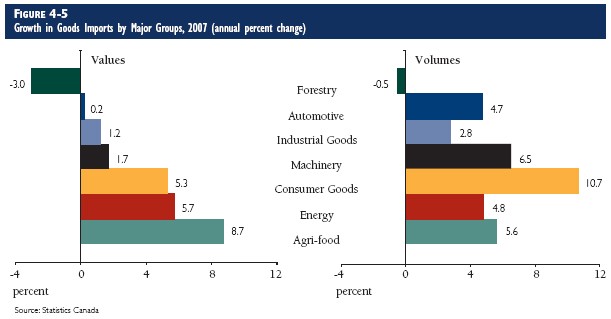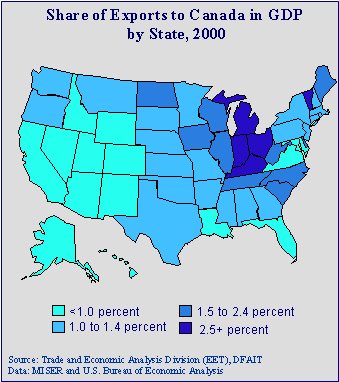Canada s Top Commodity Exports
Post on: 25 Май, 2015 No Comment

Canada has the 7th largest economy in the world and is the 2nd largest country by land mass. It has a wealth of natural resources, making it a large energy and minerals exporter. For commodity traders looking to invest primarily in North America, Canada presents a compelling opportunity. [This article takes a look at Canadas top commodity exports and imports and offers suggestions as how to invest in Canadas commodity industry.] Words: 905
So says Tim Parker (www.CommodityHQ.com) in edited excerpts from his original article* entitled A Deeper Look At Canada’s Commodity Industry .
This post is presented compliments of Lorimer Wilson. editor of www.munKNEE.com ( Your Key to Making Money !), www.FinancialArticleSummariesToday.com (A site for sore eyes and inquisitive minds ) and the FREE Intelligence Report newsletter (see sample here register here ). The post may have been edited ([ ]), abridged (…) and/or reformatted (some sub-titles and bold/italics emphases) for the sake of clarity and brevity to ensure a fast and easy read. You can also “Follow the munKNEE ” daily posts via Twitter or Facebook .
Parker goes on to say, in part:
Canadas Top Commodity Exports
Energy products are the largest of Canadas exports and, although Canada has increased energy product exports to China[dramatically], the United States remains Canadas principal energy destination, importing nearly 12 times more than China.
Canadas Top Commodity Imports
Canada is the 12th largest commodity importer in the world of which more than half comes from the U.S.
- Crude Oil: Canadians import approximately 295 million barrels per year for a net expense of $12.2 billion. Imports take place primarily in the winter months when heating energy needs increase and, to a slightly lesser extent, during summer months during peak driving months.
- Natural Gas: Canada imports nearly 700 billion cubic feet of natural gas at a cost of $3.6 billion. As natural gas prices have fallen, Canada has imported more natural gas but spent less on it. The majority of Canadas natural gas imports come from the United States.
- Electricity: Canada and the United States share an integrated electrical grid serving as importers and exporters to each other in order to meet nearly all of each others electrical energy needs. This not only provides for the energy needs of each country but also serves as a key element of national security.
- Food Products: The country imports more than $35 billion in agri-food imports each year. Canola and non-durum wheat top the list for a combined $8 billion. Soybeans, pork, bread, coffee, and frozen snow crabs are among the many other food items imported from the United States and other countries.
Stay connected!
Ways to Play the Market
Below, we outline several ways to make a play on Canadas massive commodity industry.
- Guggenheim Canadian Energy Income (ENY) is an ETF that seeks to replicate the performance of the Sustainable Canadian Energy Income Index-an index of 200 securities listed on the Toronto Stock Exchange representing the Canadian oil and gas industry.
- IQ Canada Small Cap ETF (CNDA) puts more than 75% of its assets in Canadian firms that fall under the energy and basic materials sectors.
- MSCI Canada Index Fund (EWC) is an ETF that focuses on broad Canada exposure, but over 45% of its assets are dedicated to the energy and basic materials sectors.
- Gold Explorers ETF (GLDX) invests in gold exploration companies of which nearly 95% of assets are dedicated to Canadian firms.
- Market Vectors TR Gold Miners (GDX) has over 65% of its assets in Canadian companies.
- Pengrowth Energy Corporation (PGH) explores and develops oil and natural gas reserves in Canada[with] about 4,000 producing and 1,400 non-producing oil and natural gas wells in Alberta, British Columbia, Saskatchewan and Nova Scotia.
- NovaGold Resources Inc. (NG) is a miner of gold, silver, copper, zinc and lead ores primarily in Alaska and British Columbia. NovaGold is headquartered in Vancouver.
- TransCanada Corp. (TRP) operates natural gas and oil pipelines in the United States and Canada. It currently owns 57,000 kilometers of natural gas pipelines and nearly 3,500 kilometers of crude oil infrastructure. In addition, TransCanada has interests in power plants with a combined total capacity of nearly 11,000 megawatts.

Related Articles:
Commodity investing has been around for decades, but it was only recently that their popularity has spread to the general public. It is now generally recommended that investors set aside anywhere from 5% to 10% of their capital for a commodity allocation, as these hard assets generally offer uncorrelated returns essential to diversification. While many investors utilize stocks, ETFs, and futures to obtain their commodity exposure, options contracts can often be a better alternative to not only your commodity holdings, but for the remainder of your portfolio as well [Let me tell you more about options and also why they might/should have a place in your portfolio]. Words: 995
Commodities have obvious appeal to active investors looking to generate profits from short-term price movements [but while] the volatility of this asset class is ideal for risk-tolerant individuals who actively monitor their positions…commodities may also have appeal to the long-term, buy-and-hold crowd…These potentially appealing attributes come with plenty of risk, [however, as] the path to commodity exposure is full of potential obstacles and pitfalls that can erode returns and lead to a less-than-optimal investing experience. Here are ten rules of thumb that will help you achieve a more successful experience investing in commodity markets. Words: 2871
The Canadian oil sands are the world’s single largest petroleum resource at 1.7 trillion barrels. With conventional oil supply decreasing, heavy oil projects such as the oil sands become more attractive economically to meet the needs of growing demand. While environmental concerns about the oil sands remain, the options for plentiful, cost efficient, and clean oil sources are limited.
The following charts come straight from the Canadian Association of Petroleum Producers in an attempt to put the benefits and impact of Alberta, Canada’s oil sands into proper perspective from their point of view. Take a look and I think you will be favourably impressed. Words: 540
Canada is the largest supplier of oil to the U.S. When the U.S. imports oil from Canada, the spin-off economic benefits are substantial. The interactive map of the U.S. below will let you calculate the economic impact generated in each U.S. state from new oil sands projects in Alberta, Canada. Words: 592
The third largest source of oil in the world is the Canadian oil sands and the United States already imports more of it from there than from anywhere else. With oil prices on the rise, the controversial oil sands are likely to become even more economically viable, despite experts’ warnings about environmental risks [and the political and environmental gamesmanship to block the Keystone pipeline project from there to refining facilities in the U.S.]. Below are 12 incredible facts about the oil sands. Words: 408
The oil sands in northern Alberta are crucially important to the Canadian economy. People from all over the country are traveling there to find work. The news is filled with controversy over proposed pipelines (the Keystone XL and the Northern Gateway) to carry the oil to export markets. Here are 10 things everyone should know about the oil sands. Words: 878
Gold is one of the rarest metals in the world, and has a long history as a valuable and intensely sought-after element. The precious metal has served as the basis for physical currency for thousands of years, and many monetary systems throughout human history have utilized a gold standard that focused on the precious metal. Exploration and production of gold has become a major industry in regions that maintain significant deposits of the metal, and quests for gold have been the impetus of countless expeditions and discoveries. [Below are a list of the top 10 gold producing countries, the top 10 gold producing companies and a definitive guide as to the multiple options of investing in the metal.]
Silver has been an important metal for thousands of years, often used as a medium of exchange or jewelry in ancient times….Today, silver still finds its way into jewelry and coins but it is now also a key ingredient in many ‘modern’ applications as well….Due to this multitude of uses the metal has continued to be a popular investable asset…[as well] as a store of value and an inflation hedge. Below are a list of the top 10 silver producing countries, the top 10 silver producing companies and a definitive guide as to the multiple options of investing in the metal. Words: 2091
The shale revolution has come as a surprise to many, but natural gas is now so plentiful and cheap that it could be an energy game changer. This infographic explores natural gas, its properties, natural gas market dynamics, supply forecasts, demand, the shale revolution, and the switch from coal to natural gas.
Coal, hydroelectric and oil are increasingly in high demand to meet the world’s growing appetite for power. In fact, global energy consumption grew 5.6 percent in 2010, the highest rate since 1973. Discover 10 other fascinating facts about worldwide consumption in this informative slide show.
[Although] investing in natural gas is an incredibly popular and active sector of the commodity world given its robust growth predictions,…it tends to exhibit violent daily swings with high and liquid volumes. While this can lead to significant losses, for those who play their cards right, trading natural gas can make for a nice short term reward. [That being said,] for the more traditional “buy and hold” investor there are still a number of options that, [while they] may not directly invest in the commodity, offer significant exposure under a safer structure. [In this article I have identified 25 ways to invest in natural gas to help investors pick the correct security for their portfolio]. Words: 1800
Natural gas is increasingly becoming an important fuel in meeting the global energy needs. Let’s take a quick look at the largest natural gas fields in the world. Words: 300














